
Acronicta haesitata, the hesitant dagger moth, is a moth of the family Noctuidae. The species was first described by Augustus Radcliffe Grote in 1882. It is found in North America from Nova Scotia to South Carolina, west to Texas, north to Ontario.
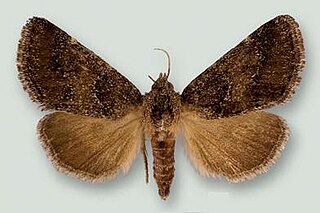
Schinia saturata, the brown flower moth, is a moth of the family Noctuidae. The species was first described by Augustus Radcliffe Grote in 1874. It is found in the United States from south Texas to South Dakota, southeast Arizona and from Florida to South Carolina.

Schinia nundina, the goldenrod flower moth, is a moth of the family Noctuidae. The species was first described by Dru Drury in 1773. It is found in North America from Minnesota to southern Ontario and Nova Scotia, south to central Florida and southern Texas. Records include Arizona, Kansas, Nebraska, New York, Maryland, Oklahoma and South Carolina.
Cissusa indiscreta, the indiscreet cissusa moth, is a species of moth in the family Erebidae. The species is found from British Columbia, south to California and in the south-west from Arizona to central Colorado. The habitat consists of oak woodlands and mixed hardwood forests.

Lophocampa maculata, the spotted tussock moth, mottled tiger or spotted halisidota, is a moth of the family Erebidae and the tribe Arctiini, the tiger moths. The species was first described by Thaddeus William Harris in 1841. It is found across Canada, the western parts of the United States, south in the Appalachians to South Carolina and Kentucky.
Abrostola ovalis, the oval abrostola, is a moth of the family Noctuidae. The species was first described by Achille Guenée in 1852. It is found in north-eastern North America from southern Quebec and Maine south to North Carolina and west to Wisconsin.
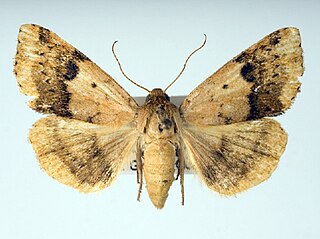
Heliocheilus lupatus, the purple topper, lupatus straw moth or spotted straw moth, is a moth in the family Noctuidae. The species was first described by Augustus Radcliffe Grote in 1875. It is found in the United States from Kentucky and central Connecticut south to Florida and Texas.

Macrochilo litophora, the angulate fan-foot or brown-lined owlet moth, is a litter moth of the family Erebidae. The species was first described by Augustus Radcliffe Grote in 1873. It is found in the United States from Wisconsin, east to Massachusetts, south to North Carolina, South Carolina, Mississippi and Texas.
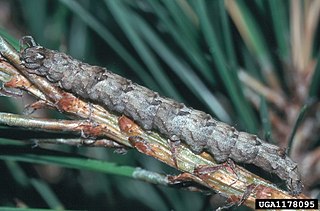
Zale metatoides, the washed-out zale or jack pine false looper, is a moth of the family Noctuidae. The species was first described by James Halliday McDunnough in 1943. It is found in barrens and pine woodlands from at least Wisconsin and probably Manitoba to Maine, south to the mountains of Georgia. The range in the Gulf States is not certain.
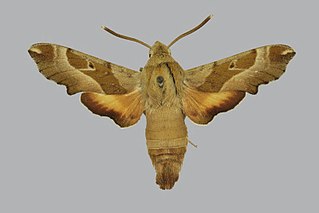
Proserpinus gaurae, the proud sphinx moth, is a moth of the family Sphingidae. The species was first described by James Edward Smith in 1797. It is found from Texas and Louisiana east to northern Florida, north to Alabama, Missouri, northern Georgia and South Carolina. It may range as far south as northern Mexico.

Brenthia pavonacella, the peacock brenthia moth, is a moth of the family Choreutidae. It is found in North America, including Illinois, Maryland, Iowa, Oklahoma and South Carolina. It has also been recorded from Mexico.
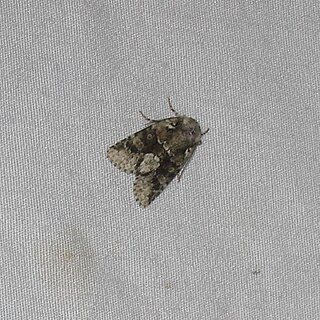
Lacinipolia explicata. the explicit arches moth, is a moth of the family Noctuidae. It is found in the south-eastern part of the United States, from Kentucky and North Carolina south to Florida and west to Missouri and Texas.
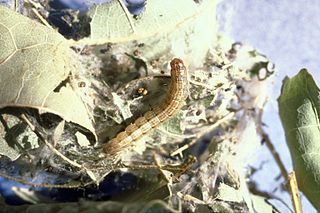
Pococera asperatella, the maple webworm moth, is a moth of the family Pyralidae. It is found in North America, including Alabama, Illinois, Massachusetts, Minnesota, New Hampshire, New Jersey, North Carolina, Oklahoma, Ontario, Pennsylvania, South Carolina, Tennessee, Texas, Virginia and Wisconsin.
Paraclemensia acerifoliella, the maple leafcutter moth, is a moth of the family Incurvariidae. It is found from south-eastern Canada and the north-eastern United States, south to the tip of the Appalachian Mountains in western North Carolina and possibly north-western Georgia.

Gretchena bolliana, the pecan bud moth or gray-flanked gretchena moth, is a moth of the family Tortricidae. It is found in the United States from South Carolina to Florida and west to Texas, Arizona and New Mexico.

Heterocampa guttivitta, the saddled prominent moth, is a species of moth of the family Notodontidae. It is found in North America, including Alabama, Arkansas, Connecticut, Delaware, Florida, Georgia, Illinois, Indiana, Iowa, Kansas, Kentucky, Maine, Maryland, Massachusetts, Minnesota, New Brunswick, New Hampshire, New Jersey, New York, North Carolina, Ohio, Oklahoma, Ontario, Pennsylvania, South Carolina, Tennessee, Vermont, Virginia, West Virginia and Wisconsin.

Argyrotaenia pinatubana, the pine tube moth, is a species of moth of the family Tortricidae. It is found in eastern North America, from Canada south to Florida and west to Wisconsin.
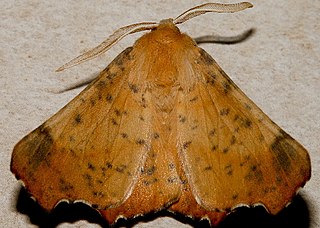
Ennomos magnaria, the maple spanworm moth, notched wing moth, notched-wing geometer or notch-wing moth, is a moth of the family Geometridae. The species was first described by Achille Guenée in 1858. It is found from coast to coast in southern Canada and the northern United States, south in the east to Florida and Louisiana and in the west to California.

Macaria minorata, the minor angle moth, is a moth of the family Geometridae. The species was first described by Alpheus Spring Packard in 1873. It is found in North America, where it has been recorded from Nova Scotia to Ontario, Quebec, Minnesota, New England, Maryland, North Carolina, South Carolina and Georgia.
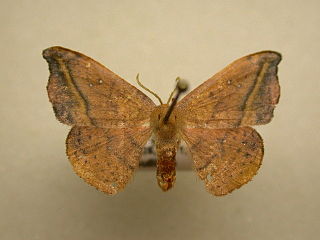
Oreta rosea, the rose hooktip moth, is a moth in the family Drepanidae. It was described by Francis Walker in 1855. It is found in North America, where it has been recorded across boreal Canada to eastern North America. In the north, the range extends to northern Alberta, northern Manitoba and Newfoundland. It is also found east of the Great Plains as far south as Florida and eastern Texas. The habitat consists of moist temperate hardwood forests.

















